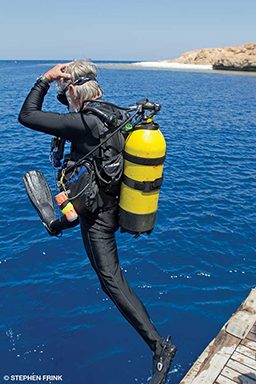I am 79 years old and healthy. I have not been diving in several years and would like to get back into it. Are there any recommendations, prohibitions or limitations for a diver my age?
Please note that DAN® is not a regulatory agency and does not set standards or guidelines for participation in diving. Any age or fitness limitations you encounter would come from training agencies or dive operations, not DAN. The responsibility for the decision of whether or not to dive is generally that of the individual and his or her physician. This decision, however, should be based on the most current diving medical information available.

Many people in their 70s and 80s continue to dive, although their diving style may change over time. The key to safe diving is physical fitness, not age. Or as some people glibly state, “It’s not the age but the mileage that counts.” An athletic, physically fit senior citizen may be a better candidate for diving than a 25-year-old in poor physical condition. But that same person will never match the physical capabilities of an athletic 25-year-old. All tissues — blood vessels, heart, lungs, muscles, etc. — age.
A thorough cardiac workup and stress test are prudent and probably the first priorities. Many cardiologists familiar with dive medicine recommend a cardiac stress test targeting a score of 13 metabolic equivalents (METs), while others recommend a minimum of 10 METs. Either level is rigorous exercise. While most diving is relaxing, a strong current, a long surface swim or rescuing a buddy (or oneself) all require a high level of exercise tolerance.
Awareness of underlying medical issues is of practical use. The basic aches of arthritis could be confused with decompression sickness, so conservative profiles are recommended for anyone who deals with this issue. Also, diving in locations with reasonable access to medical care is prudent. Anyone can have a medical or diving emergency, and age makes medical emergencies more likely. A minor issue that occurs within reasonable access to medical care can be handled easily. The same issue can be much more problematic on a remote island or liveaboard hours or days from medical care.
— Frances Smith, EMT-P, DMT
I know nitrogen is not metabolized by the body, and I’ve read that tech divers are facing issues with helium bends. Is the size of the molecules relevant? Helium molecules are smaller and lighter than oxygen molecules, while nitrogen molecules are larger. Some people are filling their car tires with nitrogen because it supposedly leaks out of the tire more slowly than air.
There are times when size matters and times when it is a red herring. This is one of those cases where it’s a little bit of both. Nitrogen is a slightly larger molecule than oxygen (by about 2 percent), but that does not have anything to do with its reactivity in the body. A better analogy would be how wood and steel interact with a magnet. The steel reacts, while the wood does not.
A helium molecule, on the other hand, is one-third the size of a nitrogen molecule. Molecule size can make a difference in passing through some barriers, but it is almost certainly not the only factor in uptake and elimination or its nonnarcotic nature relative to nitrogen. Interestingly, while helium is considered a fast gas in terms of exchange, it can cause challenges in decompression, resulting in the need for more buffering of limits based on expectations of exchange speed. You may be hearing more about decompression related to helium in large part because of its increased use by recreational technical divers. Broadening the use sometimes brings out new issues not discovered in more limited traditional use.
As I like to say, physiology does not equal math. Physiology is much more dynamic. Seemingly logical ideas, such as size being a critical factor, can be attractive but do not answer the question. Asking questions, though, and having a lifelong interest in learning are critical in getting closer to the elusive truth.
By the way, it is not worth paying to fill your tires with nitrogen.
— Neal W. Pollock, Ph.D.
Why does it seem like the answers I read in Alert Diver or on DAN.org are so conservative? You advise caution for medical issues I would never give a second thought to when participating in other activities such as skiing, tennis, basketball or exercising at the gym. It seems like your organization is afraid for anyone but the healthiest people to dive.

Many divers have medical conditions and/or take medications and enjoy diving without any problems. DAN’s role is to provide information based on the available literature and prevailing expert opinions in diving medicine, not to decide who is allowed or prohibited from diving. We advise divers (and potential divers) and their doctors so they can make thoughtful and informed decisions about diving. Sometimes DAN recommends that divers or potential divers be evaluated by a physician who has special training in diving medicine.
Hazards exist in the diving environment that are not present in most other recreational activities. If someone playing basketball gets dizzy or short of breath, he or she can easily stop the activity and rest. If a medical emergency arises, emergency medical services are readily available. The underwater world, however, is unforgiving, and problems can increase the risk of drowning. Shortness of breath, for example, does not always resolve with rest while underwater because of the increased resistance involved in breathing through a regulator. It is important to remember that when scuba diving we are using life-support equipment to explore an environment not conducive to human survival.
— Scott Smith, EMT-P
I recently returned home from a two-week liveaboard dive trip. After experiencing some initial motion sickness while adapting to the motion of the boat, I had a wonderful trip. At the end of the trip, however, I felt like the dock was rocking when we disembarked. I was queasy and almost vomited. This feeling continued for nearly a week before resolving. Why did this happen?
While we cannot say with certainty what caused your symptoms, you may have been suffering from condition that’s known by various names including land sickness, disembarkment syndrome and mal de debarquement syndrome (MdDS). This syndrome occurs when the brain, having adjusted to the constant movement of the ship, has essentially forgotten how to handle a solid surface beneath the feet. The body finds the sensations of being on firm ground unfamiliar and abnormal. The vestibular system, which controls the body’s balance, is disrupted and typically takes a few hours to a few days to readjust to being on a nonmoving surface. Some individuals, however, report a much longer time for resolution. No test can definitively diagnose disembarkment syndrome; diagnosis is based on the exclusion of reasonable alternatives.
While the main symptoms are a persistent rocking sensation and a sense of imbalance, other symptoms may include dizziness, fatigue, migraines, depression, nausea, difficulty concentrating and confusion. Typically, the condition is more pronounced when the person is sitting or lying down. Unlike motion sickness, the symptoms of disembarkment syndrome may improve with motion such as walking or riding in a vehicle.
It is impossible to predict whether an individual will suffer from disembarkment syndrome after a cruise or voyage. Those who readily adjust to the motion of the sea seem to be more susceptible. Disembarkment syndrome is more common in women than men, but a specific hormonal tie has not been detected. To decrease the likelihood of disembarkment syndrome, start seasickness-prevention measures a few days before boarding a ship and continue them for a few days after returning to land.
According to the MdDS Balance Disorder Foundation, there is no treatment for the condition since it typically subsides on its own. Motion-sickness medications such as meclizine or scopolamine are not effective with MdDS. Instead, clonazepam, benzodiazepines or amitriptyline may be beneficial. Additionally, light physical activity such as walking or yoga, taking naps, and possibly acupuncture may help strengthen the vestibular system.
Resources for additional information include the National Institutes of Health, the National Organization for Rare Disorders and the MdDs Balance Disorder Foundation.
— Frances Smith, EMT-P, DMT
In a recent DAN article about exercise and diving, I read the following:
Intense physical activity — generally with substantial muscular forces and joint loading (the application of forces on joints) — is believed to transiently increase micronuclei activity, the presumed agent of bubble formation.
Are these micronuclei preexisting? Where do micronuclei come from, and how are they formed or created?

The source point for bubble formation is one of the great mysteries in diving science. We know that bubbles form at relatively low gas supersaturations, suggesting some biological facilitation of the process, but we do not yet have the imaging tools to see the initial formation. This technology will come, but it’s not available yet. Other methods to identify the sites of formation also continue.
Micronuclei may comprise multiple structures. Whatever they are, they are preexisting, and their activity of facilitating bubble formation can be influenced by acute events (most notably recent pressure excursions that act as preconditioning to alter the responsiveness). Altered responsiveness appears to be transient, indicating a dynamic state or ongoing replacement. If you want to see micronuclei in action, look at a glass of beer. You can often see streams of bubbles originating from apparently singular points on the side of the glass. These points are often associated with defects in the glass, effectively small cracks within which micronuclei formation points exist. It is thought that the micronuclei are lodged in the cracks and act to crank out bubble after bubble. Even if this cannot provide all the answers, it can make for a pleasant interlude if you enjoy beer.
Ultimately, we can see bubbles best in the vascular system, and we have a good idea when they develop and what effects they can have. When we are vague on the specifics of the actual formation, it is an honest acknowledgment of understanding yet to come.
— Neal W. Pollock, Ph.D.
© Alert Diver — Q2 Spring 2016